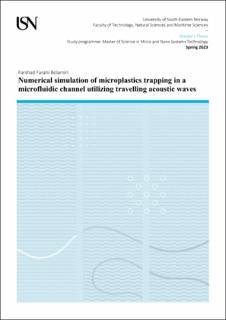| dc.description.abstract | A numerical simulation based on a novel acoustofluidics model with travelling surface acoustic waves has been provided. An acoustic radiation force equation from travelling acoustic waves has been introduced to COMSOL Multiphysics finite element model software. This new model has been validated through an example and characterized by simulating microparticles trajectories through changing the size and density of microparticles as well as driving conditions such as normal inflow velocity of microchannel, voltage, and frequency of travelling surface acoustic waves resonator. This model can be used to trap microplastics on top of a microchannel in order to quantify them in a sample.
Acoustic radiation force has been discussed analytically and some important simulation results of acoustic fields such as total acoustic pressure and velocity as well as stationary field of velocity magnitude of laminar flow in microchannel have been provided. These results are used to simulate microplastics trajectories in the microchannel. In describing the modelling process in COMSOL, it is tried to be written like a tutorial so that it could be useful for those who are interested in modelling acoustofluidics domains.
Simulation results show that by choosing appropriate design parameters such as microchannel flow rate, voltage, and frequency of surface acoustic wave resonator, microplastics with diameters bigger than 7 micrometre and density of 950 kilogram per cubic metre can be trapped on the ceiling of microchannel above the resonator. | |
